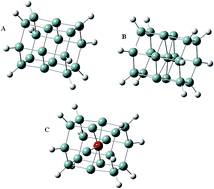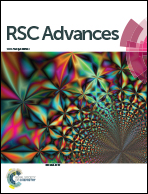Intriguing properties of unusual silicon nanocrystals†
Abstract
Solar cell technologies are highly dependent on silicon materials and novel nanoclusters with optimal electronic properties. Based on a recent study on ultrastable silicon nanoclusters, an analysis of the effects of modifications of those nanocrystals by carboxylation, amidation, hydroxylation and halogenation has been performed using quantum mechanical methods of study. Here we report the gaps, electronic structures, absorption spectra, and effects on the charge-transfer potential of a collection of modified silicon nanoclusters. The results show that the pristine silicon clusters retain the highest charge-transfer properties and that halogenation impacts on the charge-transfer effects in a proportional fashion to the electronegativity of the employed halogens. Modification with organic molecules does not improve charge-transfer properties, and gives instead the highest reduction of charge-transfer potentials of the silicon clusters. The effects of the modification have also been studied in context with the orbital configurations through wave function analysis, which reveals that the electrostatic properties of the nanoclusters are mainly represented by a significant polarization of the electrostatic energy between the peripheral regions of the clusters and their core, a feature particularly well-preserved in the pristine silicon clusters. Modifying the particles by adding an extra atom at their core shows significant effects on the molecular orbital properties (HOMO/LUMO). However, this modification does not contribute to an actual increase in charge-transfer integrals. The modifications induce, however, interesting effects on the overall configuration of the clusters; i.e., they increase the aromatic character of the inter-atomic bonding pattern. Halogenation has the highest effect on improving aromatic properties for the silicon clusters, where chlorination gives the highest degree of aromaticity. This study introduces valuable electronic data for engineering novel silicon nanoclusters for application in solar cell technologies, computing units, and other fields such as in aerospace engineering.


 Please wait while we load your content...
Please wait while we load your content...